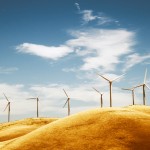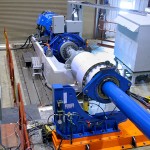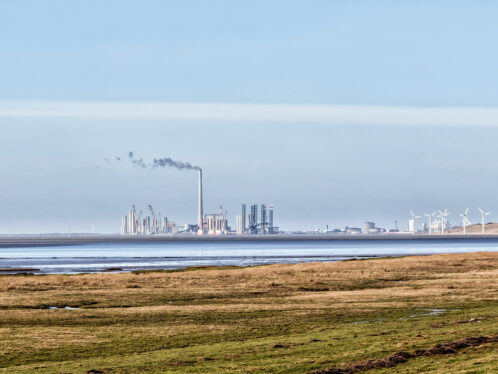
Wind warnings
At the National Renewable Energy Laboratory, a group of experts are joining forces to study serious challenges with wind turbines.
Wind, it turns out, is at least part of the answer to the world’s energy problems. Many energy experts believe that in some parts of the world, wind can be harnessed to supply as much as 50 percent of needed electricity. Today, Europe has plans to reach that 50 percent mark by 2050, and the United States is looking at a scenario that could achieve 20 percent by 2030. Despite all the potential wind poses though, the job of converting wind into mechanical energy, and from there into electrical energy, poses substantial challenges. The wind turbine, the primary tool for converting wind into electricity, is an extraordinarily complex machine with extreme requirements for precision, temperature, humidity, weight, mechanical stress and vibration. One persistent problem is the reliability of turbine gearboxes. Some are failing in as little as three years. “Right now, wind turbine gearboxes are not meeting their design life of 20 years,” says Jeroen van Dam, a test engineer at National Renewable Energy Laboratory (NREL), the US government lab that researches, develops, commercializes and deploys renewable energy and energy technologies. In fact, he says, gearbox failure is becoming a serious financial concern. The gearbox is already one of the most expensive parts of a wind turbine system, and premature failure adds to that cost through turbine downtime, unplanned and expensive maintenance and repairs, and rebuilding and increased warranty reserves. Van Dam says the problem appears to be industry-wide and not tied to any specific manufacturer or manufacturing. “It must be something we’re missing in the design process of the gearbox,” he says. In an effort to make wind turbines more reliable, NREL in 2007 formed the Gearbox Reliability Collaborative, which is a cooperative effort among researchers, universities, turbine owners and operators, consultants and bearing manufacturers, including SKF. The US Department of Energy has committed resources to the group, including a 700-square-metre facility that houses a 2.5 megawatt dynamometer for testing turbines. McNiff Light Industries, an engineering consulting firm in wind power systems, is one contributor to the group. Brian McNiff, president of the company, was also involved in the project to persuade the American Wind Energy Association to write the plan for the 20 percent supply of wind energy. “I’m just a one-person company and it costs a lot of money to participate in the association, but a couple of other people and I got the association to do it,” says McNiff. Van Dam says the group has built two identical public domain gearboxes (thus avoiding intellectual property and privacy concerns) and is putting them through extensive testing to get at the physics behind the failures. Dynamometer tests look at pure torque, loads and bending, while tests in the field look at issues related to turbulence. “We’ve collected data in both the dynamometer, under controlled test conditions, and in the field on a wind turbine,” van Dam says. “We’re now using the data to validate models and further develop models, and we’ve developed a failure database that owner operators or rebuild shops can use to document gearbox failures.” Van Dam adds that while the researchers haven’t unearthed any single reason why gearboxes aren’t meeting their design life, the project has generated “a lot of insight and data” that’s being used to improve knowledge of what happens inside a wind turbine gearbox. This information has increased the group’s ability to model gearbox behaviour properly. In all, says van Dam, more than 130 channels of data have been collected, including data on strain inside the planet bearings, stresses along gear teeth and shaft deflections. In future, van Dam says, the group will focus on digesting all the data collected to date and will define the next stage of testing in the field and in the dynamometer. “This might mean some slight modifications to the gearboxes, to study the effect of those changes,” he says, “or it might mean additional instrumentation or different loading conditions. We expect any lessons learned to flow into international standards for gearbox design and testing.” SKF is playing a vital role in helping researchers create better gearboxes for wind turbines. As a partner in National Renewable Energy Laboratory’s Gearbox Reliability Collaborative, SKF is lending the group BEAST and Orpheus, two core proprietary virtual simulation tools. Greg Zimmerman, with Product Development and Testing SKF Aeroengine North America, says both tools enable engineers to evaluate a gearbox application at macro and micro levels, including the dynamic behaviour of rolling bearings and their interaction with gears and gear systems. “While many engineering software packages already provide bearing simulation, most offer a bearing representation, usually sidelining the cage or describing the bearing with simplified models,” Zimmerman says. “BEAST captures the complexity of modern rolling bearings. These form the bridge between rotating and static parts and are often a key element in determining the behaviour of the complete application.” Zimmerman adds that SKF is using Design for Six Sigma (DfSS) in the modelling process, which introduces a framework for optimized evaluation of selected bearing arrangements. “Engaging the DfSS enables a structured approach and toolbox to identify critical-to-performance operating parameters,” he says. SKF’s tools will be compared with test data and other tools being used by the industry. The system outputs will help the industry understand the advantages and limitations of drivetrain conditions.
BEAST and Orpheus to the help






